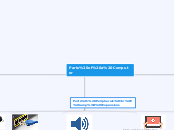Parts of a Computer
Core

Motherboard:
the main circuit board of
the computer that connects
everything together.

CPU:
The primary component
of a computer that processes
instructions.

RAM:
Random access memory.

Hard Drive:
A data storage unit that uses
magnetic storage to store and
retrieve digital information.

Cooling Device:
A fan that keeps a computer
cool while it is running, so it
doesn't overheat and take
structural damage.
Ports, Peripherals
& Expansions

Graphics Card:
An attachment that enhances
the graphics of a computer.

USB:
An attachment that connects
another digital device to a
computer.

Ethernet:
A system for connecting a
number of computer systems
to form a local area network.

Audio:
Sound, especially when
recorded, transmitted,
or reproduced.

Microphone:
An instrument for converting
sound waves into electrical
energy variations, which may
then be amplified, transmitted,
or recorded.

Headphones:
A pair of earphones typically
joined by a band placed over
the head, for listening to audio
signals such as music or speech.

Video:
A recording of moving visual
images made digitally or on
videotape.

Webcam:
A video camera that inputs to a
computer connected to the
Internet, so that its images can
be viewed by Internet users.

Monitor:
A computer monitor is an output
device which displays information
in pictorial form.

Keyboard:
A panel of keys that operate a
computer or typewriter.

Printer:
a machine for printing text or
pictures onto paper, especially
one linked to a computer.
Operating
System

Process Management:
An access control method
in which owners or
administrators of the
protected system,
data or resource set
the policies defining
who or what is
authorized to
access the resource.

Memory Management:
The functionality of an operating
system which handles or manages primary memory and moves processes back and forth between main memory and disk during execution.

Device Management:
Within the computer, activating
and controlling the peripheral
devices. In a desktop computer,
the operating system interacts
with the device drivers for
peripheral control. In very small
embedded systems, the device
management routines may be
included within the OS
Storage Management:
The functionality of an operating system which handles or manages primary memory and moves processes back and forth between main memory and disk during execution. Memory management keeps track of each and every memory location, regardless of either it is allocated to some process or it is free.

User Interface:
the part of an operating system, program, or device that allows a user to enter and receive information. A text-based user interface displays text, and its commands are usually typed on a command line using a keyboard.
